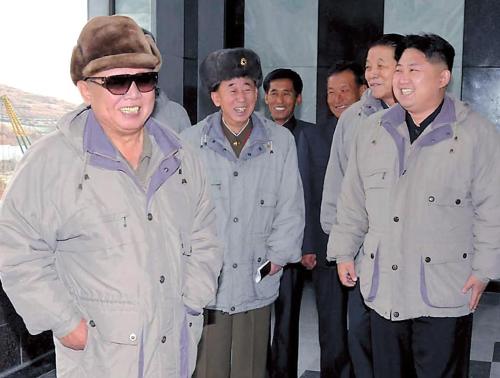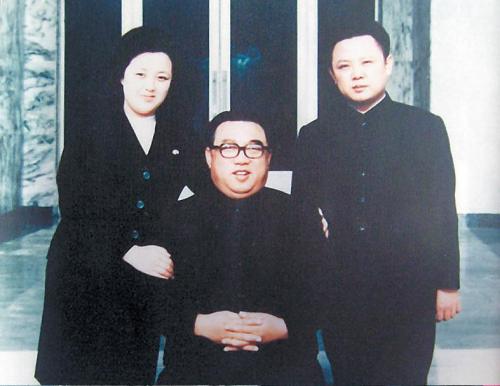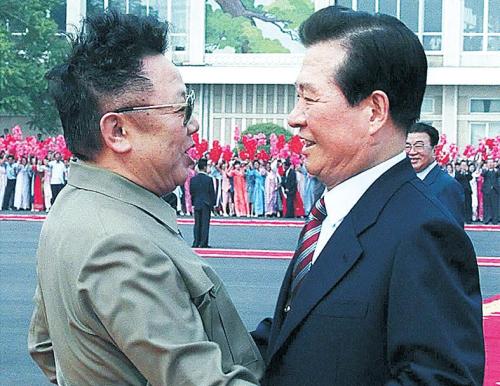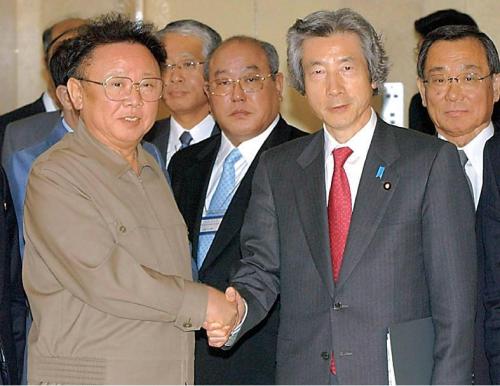
Kim Jong-il and his son Jong-un (right) visit a factory for field inspection in an undated photo released by the North Korean Central News Agency on Nov. 25, this year.
North Korea’s leader Kim Jong-il, who died on Saturday, had ruled the communist state for nearly 40 years with an absolute power that no one else in the Hermit Kingdom dared to challenge.
Although he officially took his Defense Commission chairmanship in 1998 after his predecessor Kim Il-sung’s death in 1994, Kim Jong-il’s actual ruling of North Korea began in 1974 when he was officially designated as the successor of Kim Il-sung.
According to the official biography by North Korean authorities, Kim Jong-il was born on Feb. 16, 1942 as the eldest son to Kim Il-sung and his first wife Kim Jong-suk in a secretive military camp on Mount Baekdu. However, records from the former Soviet Union say Kim was born in 1941.
North Korea had been presenting his birth year as 1941 until 1974, but later changed it to 1942 to coincide with the celebrations of Kim Il-sung’s 70th birth anniversary in 1982.
The entire state of North Korea celebrates the birthdays of Kim Il-sung and Kim Jong-il as the state’s largest holidays, especially every five or 10 years.
Also, the birthplace of Kim Jong-il had been distorted, according to Soviet records, as it was actually a guerrilla camp in Russia where his father was in exile, having fought Japanese forces in China during Japan’s colonization of the Korean peninsula.
Although Kim Jong-il was the eldest son of North Korea’s top leader, his childhood was checkered with a series of unfortunate incidents. His brother Shura Kim drowned in a pool in 1948 and his mother died the following year, when he was just 7.
He was raised by stepmother Kim Song-ae, but following his mother’s death was reportedly hostile to his stepmother and siblings born of different mothers.
Reports said his sense of deprivation affected his relationship with Song Hye-rim, North Korean actress and his one-time favored mistress five years his senior.
From 1950 to 1960, he received a general education, attending Primary School No. 4 and Namsan Higher Middle School in Pyongyang.
In 1960, Kim entered Kim Il-sung University’s political economics department.
After graduating in 1964 from the university, Kim began his climb through the ranks of the ruling Workers’ Party.
Power struggle
1964 to 1974 were a critical time for Kim Jong-il to accumulate his experience, improve his skills and receive his father’s approval for succession.
Taking advantage of position as eldest son, he investigated the activities of dissidents and reported them to his father.
He was in charge of the arts sector in the Workers’ Party, creating movies, dramas and novels that helped amplify the story of his father’s fight against Japanese forces and strengthening the legitimacy of the North Korean regime.

Kim Jong-il, his father Kim Il-sung and his younger sister Kim Kyung-hee pose for a photo. (Yonhap News)
With Kim Il-sung’s trust, Kim Jong-il was able to fight off Kim Pyong-il, his half-brother, in a power struggle and rose to become the party’s secretary of organization and propaganda in 1973.
In February 1974, he became Kim Il-sung’s official heir.
Kim gradually increased his power in domestic affairs over the following years.
To gain full power, he concentrated most of his efforts on eliminating relatives who were his main political rivals.
He defined his stepmothers and their children as “side branches” and banished those who were involved with them in any way from 1975.
From around this time, Kim Jong-il’s power also affected the economy.
To increase his stature in the party, Kim put all important factories and farms across the state under the party’s control, creating “the party economy.”
While enhancing his chances of succession and venerating his father, his economic directives in the 1970s were based on his own needs and led to the overall downturn of the North Korean economy, observers said.
After he was given senior posts in the Politburo and Military Commission in 1980, his control within the party was greatly boosted.
Through the Sixth Party Congress in October 1980, his rank was made virtually equal to that of his father.
After being named supreme commander of the North Korean armed forces in 1991 and state leader in 1992, the younger Kim was officially given the title of chairman of the national defense commission, in 1993.
Assuming command
With the death of Kim Il-sung in July 1994, the younger Kim began ruling the communist state under the name of “Dear Leader.”
However, North Korea was in a dire situation in almost every sector in the early 1990s.
Pyongyang itself described the era as a “painful march,” while millions of North Koreans died during the famine due to the imploded food distribution system.
Outside the country, the North was in conflict with the U.S. over its nuclear program while facing difficult diplomacy with China and Russia, its traditional allies, due to their establishment of diplomatic ties with South Korea.
After finishing the three years of mourning over the death of Kim Il-sung, the younger Kim became General Secretary of the Workers Party in September 1997.
With the launch of Kim Jong-il’s era, he adopted a “military-first” policy to reinforce the regime.
Kim strove to make a breakthrough by making changes in the constitution and appointing young technocrats in the Cabinet but they did not have a strong impact in improving the local economy.
However, Kim’s diplomacy was deemed exceptional.
After pulling off the 1994 Agreed Framework with the U.S. which aims to freeze and eventually dismantle the North’s nuclear weapons program in return for aid in producing two power-generating nuclear reactors, Kim pushed forward active inter-Korean exchanges when the South was led by the Kim Dae-jung administration.
In 2000, the two Koreas held a historic summit in Pyongyang and the North Korean leader signed the June 15 Joint Declaration with then South Korean President Kim Dae-jung.

North Korean leader Kim Jong-il (left) and South Korean President Kim Dae-jung embrace as they bid farewell at Sunan airport outside Pyongyang on June 15, 2000.

Japanese Prime Minister Junichiro Koizumi shakes hands with North Korean leader Kim Jong-il after their summit meeting in Pyongyang on May 22, 2004.
The North Korean leader also met with former U.S. Secretary of State Madeleine Albright and pushed for a summit with former U.S. President Bill Clinton.
Kim Jong-il’s approach to diplomacy was very different from that of Kim Il-sung.
While his father put much focus on diplomacy with Pyongyang’s allies, the younger Kim belatedly admitted the collapse of Eastern Europe and reforms of other communist states.
However, Kim’s military-first policy overrode his efforts to improve the relationship with the Western world.
North Korea conducted an underground nuclear test in October 2006, boasting its military power but worsening Pyongyang’s relations with the international community.
Since the conservative Lee Myung-bak administration took office in early 2008, inter-Korean relations have grown frostier.
Seoul and Washington blamed North Korea when there was a deadly torpedo attack in March 2010 on a South Korean warship. In November of that year, the North bombed Yeonpyeongdo in the South, killing two South Korean marines and two civilians. It was the first attack on a civilian area since the 1950-53 Korean War.
After suffering from an apparent stroke in August 2008, Kim internally designated his third son Jong-un as an heir in 2009.
By Kim Yoon-mi (
yoonmi@heraldcorp.com)
Chronology of Kim Jong-il
The following is a chronology of major events related to North Korean leader Kim Jong-il who died on Saturday of a massive heart attack while on board a train during one of his field trips.
•Feb. 1942: Born at a secret military camp on Mount Paekdu in Yanggang Province, according to N.K. propaganda.
•July 1961: Joined the ruling Workers’ Party of (North) Korea.
•Sept. 1973: Appointed as the party’s secretary of organization and propaganda.
•Feb. 1974: Designated by his father and national founder Kim Il-sung as his successor.
•April 1993: Elected as chairman of the National Defense Commission, the highest military decision-making body of North Korea.
•July 1994: Took over leadership of North Korea upon Kim Il-sung’s death.
•May 2000: Visited China for the first time as the North Korean leader at the invitation of Chinese President Jiang Zemin.
•Aug. 2008: Collapsed from a stroke.
•August 2011: Visited Russia’s Far East and Russia.
•Dec. 17, 2011: Died during a train trip.
(Yonhap News)









![[From the Scene] Monks, Buddhists hail return of remains of Buddhas](http://res.heraldm.com/phpwas/restmb_idxmake.php?idx=645&simg=/content/image/2024/04/19/20240419050617_0.jpg&u=20240419175937)
